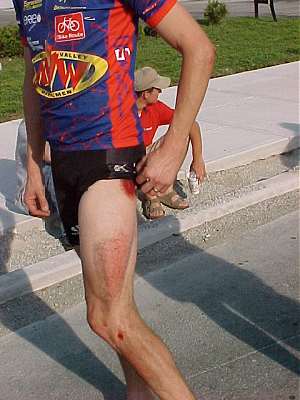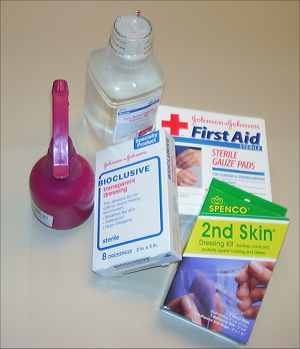
Like many other things in this modern age, change has hit here too. We've said before that most road rash can be healed in a week, if you go about it right. Let it stay dirty, or get infected, or let it dry out and scab over, and it may take a long, long time and leave an unsightly stain when it is finally healed. That much is still true; but our past recommendation to scrub well, cleanse with hydrogen peroxide and cover with antibiotic ointment is now revised. [Click the photo to see Steve's rash up close. The raw parts are what need the care described here.] At the bottom of the page are some comments by readers.
if you go about it right. Let it stay dirty, or get infected, or let it dry out and scab over, and it may take a long, long time and leave an unsightly stain when it is finally healed. That much is still true; but our past recommendation to scrub well, cleanse with hydrogen peroxide and cover with antibiotic ointment is now revised. [Click the photo to see Steve's rash up close. The raw parts are what need the care described here.] At the bottom of the page are some comments by readers.
R. S. Basler, MD, Garcia, M.A. and Gooding, K.S reviewed the subject in Vol 29, No. 4, April 2001, THE PHYSICIAN And SPORTSMEDICINE. The gist of their recommendations is given below. Here's what it boils down to for us:
First, you need some supplies. And it would pay you to get them now, before grief comes your way. Make a small rash-aid package for your medicine chest. You can get this stuff at a full-service pharmacy like Glenbyrne in Toledo, OH - call ahead; neighborhood pharmacies won't have the dressings. Find a new spray bottle at the Dollar Store to prevent accidental contamination from an old one you may find around the house:
 --0.9% sodium chloride solution
--0.9% sodium chloride solution- --Spray bottle
- --4" X 4" gauze pads
- --Johnson & Johnson Bioclusive Dressing, or Spenco 2nd Skin, or 3M Tegaderm. Prefer the Tegaderm.
- --Paper Tape
To deal with fresh rash: Get your post-ride shower (ouch!), not scrubbing the abrasions. Then, use the spray bottle of sodium chloride solution to clean up the abrasions, only gently scrubbing with the gauze pad if absolutely needed to remove visible gravel, etc.
The rash needs to be CLEAN - if it's not you're going to have to grit your teeth and make it clean with the gauze and salt solution. Let the wound dry.
Place the semipermeable dressing over the wound, drying the surrounding area and attaching the film with adhesive tape on dry skin. If you are using sheets too small to cover the wound, Tegaderm, for instance, will adhere to itself and can be shingled over the wound area. The dressing can remain in place for a week, but it might be better to change the dressing after a few days. (The wound should not be allowed to dry out until it has healed.) For signs of infection or if you need a tetanus booster, see your doctor. You may find yourself sweating under the dressing when you work hard on subsequent rides. Using paper tape to secure the edges of the dressing will keep it from falling off, and you may find you want to replace the dressing if it is particularly wet.
A thought: if you find yourself in the ER because you have trashed more than some skin, you might want to get pushy with whomever is about to clean up your road rash, hoping to get the treatment outlined here.
From Basler, et al.:
" ... Conventional treatment has consisted of cleansing the affected area with a mild soap and water or a mild antiseptic wash, such as hydrogen peroxide. This would then be followed with the application of antibiotic ointment along with a dry dressing. The problem with this approach lies in the fact that mechanical cleansing by scrubbing the wounds can produce increased trauma and a renewal of the inflammatory response. It has also been seen that the application of antiseptics, such as hydrogen peroxide or povidone-iodine, can actually cause harm to the tissue and interfere with function, which can further increase the injury and lengthen the healing process. Topical antimicrobials have been shown to be detrimental to fibroblasts and other cells needed for wound restoration.
In light of these findings, newer, improved methods for treating abrasions are recommended. The most advisable treatment for cleansing the wound is to flush it using a "pistol" syringe or bulb syringe containing a non-toxic surfactant, such as Shur-Clens (ConvaTec, Skillman, New Jersey) or a 0.9% sodium chloride solution, followed by the application of a hydrocolloid or semiocclusive hydrogel dressing.
A moist healing environment is provided by the dressing, which will promote cell migration, remove excess exudate, allow for gaseous exchange, and provide an impermeable barrier to bacteria and other contaminants. The moist environment provided by the proper dressing is important for optimal cell migration by preventing crust formation and allowing the wound to heal from the bottom as well as from the edges. Two basic options fulfill this requirement. One option is semipermeable film dressings, such as Bioclusive (Johnson & Johnson, New Brunswick, New Jersey) andTegaderm (3M Company, St Paul), in combination with semiocclusive hydrogels such as Spenco 2nd Skin (Spenco Medical Corp, Waco, Texas). These dressings are impermeable to water and bacteria but allow the exudate to evaporate.
Another option is the use of hydrocolloid dressings. These also offer a hospitable healing environment but differ from the semiocclusive hydrogels by absorbing the exudate rather than allowing for evaporation. In addition, the hydrocolloid dressing can remain in place for up to 7 days after being applied as can be done with the semipermiable films. Examples of hydrocolloidal dressings are Duoderm (ConvaTec, SkiUman, New Jersey) and Cutinova hydro (Beiersdorf, Inc, Norwalk, Connecticut). ...
Dave Hyland's Comments
on Road Rash
Austin, May 2, 2001
I appreciate the updated advice on road rash on the web. [Find the link to Road Rash Cure on the left navigation bar.]
Unfortunately I needed to use it last week. My road rash seems to be healing well thanks to your help. I used Tegaderm and that is good stuff. One suggestion-- in the directions it says to allow a 1/4" border of undamaged skin for the patch to stick. That is real important. The patch won't stick to the wound so if you don't get the overlap it doesn't work well. The patches will stick to themselves so if you have a wound bigger than the patch, overlap the patches until the wound is covered by at least 1/4" on all sides.
When done correctly I managed an hour swim session without having to change the patches. I'm not sure that is the best thing but the wound seems to have healed well.
I didn't use the Tegaderm on a small patch on my hip and that isn't in near as good shape as the area treated with the Tegaderm.
Blaine Hoopes
Sonoma County, California
July 11, 2001
This information really was wonderful to find. Nothing short of a miracle. Thanks for making it available.
After being cut off by a van on the freeway I lost control of my motorcycle while avoiding a collision. I found myself sliding down the road on my hands and knees doing about 60 mph. I quickly rolled onto my back and the leather jacket absorbed most of the abrasion. I came to a stop and found I could stand and walk off the road but discovered that my jacket sleeves had bunched up around my elbows and there was no skin from wrist to elbow. I was wearing jeans so my kneecaps were worn very deep as well.
I used Tegaderm and had to patch several pieces together to cover my large skinless areas. The pain relief was instant as the nerves were covered by this artificial skin. I allowed a generous border so the tegaderm had healthy skin to stick to at the edges, however my rash was so deep that it oozed a lot and the tegaderm didn't stay stuck at the edges for long. I tried all sorts of "waterproof tape" and the only one that really worked was 3M transpore. I used a piece of tape in each corner to hold the sheet tight and then used small pieces as needed to hold the sides in place. This oozed a lot for a few days but the pain was greatly reduced and new skin began to grow very quickly.
I found that shirt sleeves and pant legs quickly rubbed the edges of the tegaderm patch off and exposed the road rash. I wrapped my arms and knees with elastic bandage and this kept the tegaderm in place and kept me much more comfortable.
